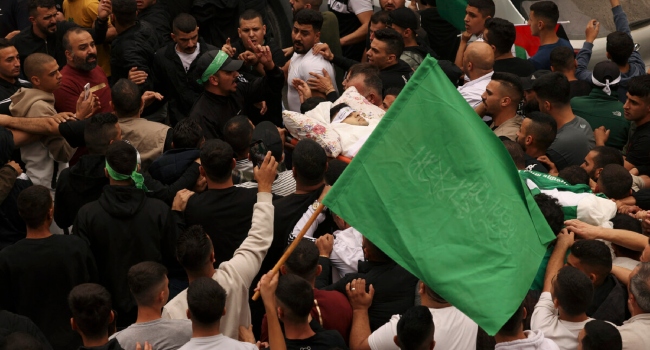Two elderly Hamas hostages were airlifted to an Israeli hospital to be reunited with family Tuesday, as the United States demanded Palestinian militants release more than 200 other captives before Gaza ceasefire talks are considered.
Hamas militants stormed into Israel from the Gaza Strip on October 7, and killed at least 1,400 people, mostly civilians who were shot or burnt to death on the first day of the raid, according to Israeli officials.
The militants also took 222 people hostage, among them elderly people and young children, according to the Israeli authorities’ latest count. The hostages include dozens of dual nationals and foreigners.
More than 5,000 Palestinians, mainly civilians, have been killed across the Gaza Strip in retaliatory Israeli bombardments, according to the latest toll from the Hamas health ministry in Gaza.
Nurit Cooper, 79, and Yocheved Lifshitz, 85, and their octogenarian husbands were among the hostages seized on October 7.
Hamas released Cooper and Lifshitz on Monday citing “compelling humanitarian” reasons, after mediation by Qatar and Egypt.
Their release comes days after a US mother and daughter were freed.
An AFP journalist saw a military helicopter bringing Cooper and Lifshitz to a medical centre in Tel Aviv early on Tuesday.
The women were wheeled into the facility on a stretcher and wheelchair, as relatives gathered nearby.
Lifshitz recounted being bundled onto the back of a motorbike and stolen away to Gaza.
“They loaded me on a motorcycle sideways so I wouldn’t fall, with one terrorist holding me from the front and the other from behind,” she told Israeli media.
“They crossed the border fence into the Gaza Strip, and at first they held me in the town of Abesan, which is near Be’eri. After that, I don’t know where I was taken.”
‘Ceasefire Calls’
In response to the worst attack in its 75-year history, Israel launched operation “Swords of Iron” — besieging Gaza and firing a near-continuous barrage of strikes to “erase Hamas” from the enclave.
While the Israeli military has claimed success in “eliminating high-ranking commanders” and destroying Hamas infrastructure, humanitarian groups have said that Palestinian civilians are paying too steep a price for the campaign.
AFP has not been able to independently verify the death toll given by Gaza’s Hamas-run health ministry, but the scale of the destruction is clear.
Thousands of buildings have been levelled and more than a million people are believed to have been displaced in the besieged territory.
Gaza City resident Ayman Abu Shamalah was among the tens of thousands who heeded an Israeli warning to flee to south Gaza.
Despite the move, he told AFP that his pregnant wife, their three-year-old son and nine-year-old daughter were killed in an Israeli air strike on Rafah in southern Gaza.
“They put my son’s shattered body in a blue bag,” he said, sobbing.
Across Gaza, water, food and other basic supplies are running out. Only a trickle of aid is being allowed to cross into Gaza from Egypt.
A few dozen trucks carrying food, medicine and water have entered Gaza since a US-brokered deal entered into operation on Saturday.
The United Nations estimates about 100 trucks are needed every day.
UN human rights chief Volker Turk called on Monday for an “immediate humanitarian ceasefire” to relieve the suffering and allow the delivery of aid.
But that suggestion was immediately slapped down by US President Joe Biden, who said any discussions about a ceasefire could only take place if Hamas frees all the hostages.
“We should have those hostages released and then we can talk,” Biden said when asked if he would support a “hostages-for-ceasefire” deal.
French President Emmanuel Macron on Tuesday became the latest foreign leader to arrive in Tel Aviv.
He is expected to express “full solidarity” with Israel and to call for the “preservation of the civilian population” in Gaza.
‘Well Prepared’
Israel has shown little sign of slowing its offensive.
On Tuesday, Gaza’s Hamas government said that Israeli air strikes during the night killed at least 140 people.
But the timing of an anticipated full-scale ground offensive remains unclear.
“We are well prepared for the ground operations in the south,” chief of staff
Lieutenant General Herzi Halevi told troops.
“The Southern Command has quality operational plans. There are tactical, operative and strategic considerations that have provided additional time,” he said.
‘Nowhere Else To Go’
Chief among those considerations may be the labyrinth of tunnels and strong points that Hamas is believed to have developed to thwart any Israeli invasion.
But there are also fears about how Hamas’s allies around the Middle East would respond to a ground war.
The US-based Institute for the Study of War has reported an uptick in attacks on Israeli and US targets from Iranian-backed groups in Lebanon, Iraq and Yemen.
There are daily exchanges of fire between Israel and Lebanon’s Iran-backed Hezbollah militant group.
At least 41 people have been killed in Lebanon, according to an AFP tally — mostly combatants but also at least four civilians, including a Reuters journalist.
And four people have been killed in Israel — three soldiers and a civilian.
The pace of evacuations has increased on both sides of the border, with the UN saying nearly 20,000 people had fled villages in south Lebanon as the fighting rages.
Israel has also ordered the evacuation of thousands of people from communities near its northern border.
But not everyone has left, with some such as 62-year-old peach farmer Moshe Dadoush, refusing to go.
“I’d be lying if I said I wasn’t afraid. But I have to stay here,” he told AFP.
“I wouldn’t leave for one simple reason: it’s here where I grew up. I have nowhere else to go but this country.”

